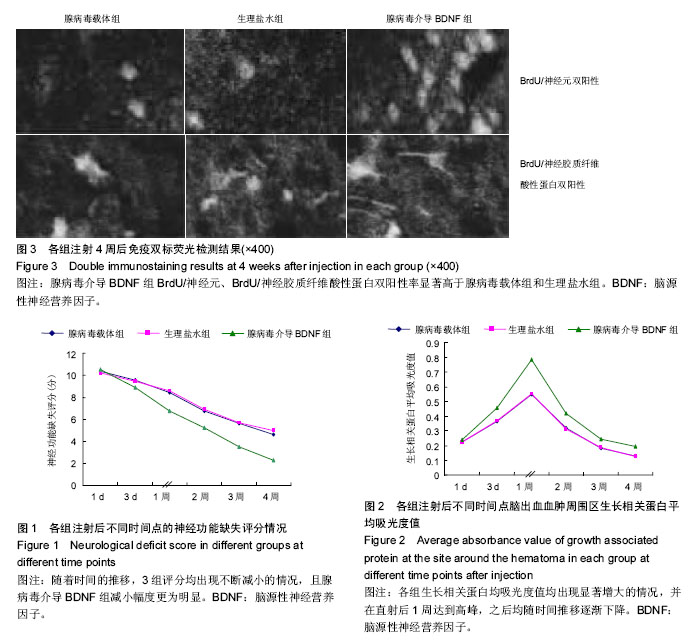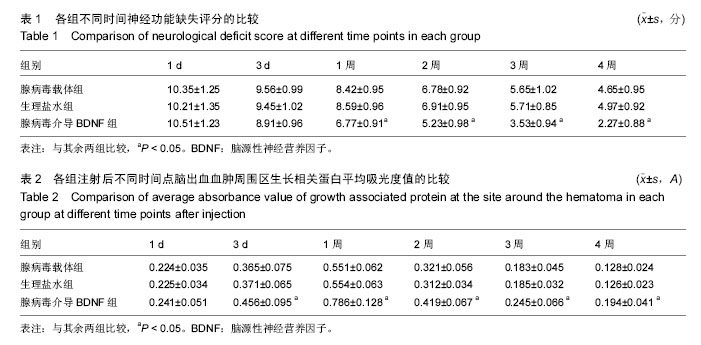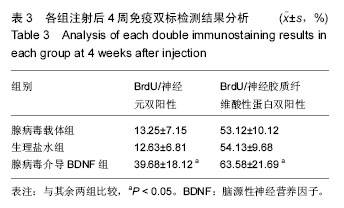| [1] 张海鸿,廖维宏,孙正义,等.腺病毒介导脑源性神经营养因子基因转移对神经根损伤后神经元的保护和促轴突再生作用[J].中华创伤杂志,2003,19(3):149-152.
[2] Koda M,Hashimoto M,Murakami M,et al.Adenovirus vector-mediated in vivo gene transfer of brain-derived neurotrophic factor (BDNF) promotes rubrospinal axonal regeneration and functional recovery after complete transection of the adult rat spinal cord.J Neurotrauma.2004;21(3):329-337.
[3] 沈岳,廖维宏,王国强,等.腺病毒介导的脑源性神经营养因子表达对大鼠损伤脊髓轴突的保护作用[J].第三军医大学学报,2000,22(2):146-149.
[4] 侯旭,胡丹,惠延年,等.腺病毒介导脑源性神经营养因子基因转染对大鼠视神经损伤后视觉电生理的影响[J].眼科新进展,2004,24(4):247-249.
[5] 廖维宏,王国强,沈岳,等.腺病毒介导脑源性神经营养因子基因转移对大鼠创伤性脑损伤后诱导型一氧化氮合酶表达及细胞凋亡的影响[J].中国危重病急救医学,2002, 14(1): 3-8.
[6] Ng BK,Chen L,Mandemakers W,et al.Anterograde transport and secretion of brain-derived neurotrophic factor along sensory axons promote Schwann cell myelination.J Neurosci.2007;27(28):7597-7603.
[7] 余震,陈莉芬,唐玲,等.腺病毒介导的脑源性神经营养因子对大鼠脑出血后内源性神经干细胞分化的影响[J].第三军医大学学报,2010,32(15):1628-1631.
[8] 张海鸿,廖维宏,孙正义,等.腺病毒介导的脑源性神经营养因子基因治疗大鼠神经根损伤[J].中国脊柱脊髓杂志, 2003,13(9):539-541.
[9] 李红乐,李浩威,邢飞跃,等.BDNF重组腺病毒的构建及在大鼠骨髓间质干细胞的表达[J].中国病理生理杂志, 2003, 19(4):438-442.
[10] Horita Y,Honmou O,Harada K,et al.Intravenous administration of glial cell line-derived neurotrophic factor gene-modified human mesenchymal stem cells protects against injury in a cerebral ischemia model in the adult rat.J Neurosci Res.2006;84(7):1495-1504.
[11] 陈先文,陈生弟,刘军,等.腺病毒介导的胶质细胞源性神经营养因子基因脑内转移对帕金森病大鼠模型的保护作用[J].中华老年医学杂志,2001,20(5):369-373.
[12] Xu K,Uchida K,Nakajima H,et al.Targeted retrograde transfection of adenovirus vector carrying brain-derived neurotrophic factor gene prevents loss of mouse (twy/twy) anterior horn neurons in vivo sustaining mechanical compression. Spine. 2006; 31(17): 1867-1874.
[13] Nakajima H,Uchida K,Kobayashi S,et al.Rescue of rat anterior horn neurons after spinal cord injury by retrograde transfection of adenovirus vector carrying brain-derived neurotrophic factor gene.J Neurotrauma. 2007;24(4):703-712.
[14] 万超,刘宁宁,柳力敏,等.腺病毒介导的脑源性神经营养因子对早期糖尿病大鼠神经视网膜病变的影响[J].国际眼科杂志,2011,11(1):31-33.
[15] 胡丹,侯旭,惠延年,等.腺病毒介导BDNF基因转染对大鼠视神经损伤后视网膜中SOD、MDA水平的影响[J].眼科学报,2002,18(4):249-252.
[16] 陈谦,汪家政,刘红,等.腺病毒介导的BDNF及NT3基因对体外培养听神经元的营养作用研究[J].生物物理学报, 2000, 16(3):511-516.
[17] 张海鸿,王栓科,孙正义,等.腺病毒介导的脑源性神经营养因子基因脊髓内转移对神经根损伤后细胞凋亡的影响[J].兰州大学学报(医学版),2010,36(2):1-7.
[18] 陈谦,刘红,吴燕,等.腺病毒介导BDNF基因对无血清培养SH-SY5Y细胞的生物学作用研究[J].中国应用生理学杂志,2002,18(4):378-381.
[19] 李琰.腺病毒介导的脑源性神经营养因子对大鼠脊髓急性损伤后神经细胞保护的研究[D].浙江大学,2013.
[20] 张惊宇,赵节绪.腺相关病毒介导的脑源性神经营养因子基因对大鼠海马神经元树突生长的影响[J].中国脑血管病杂志,2009,6(2):84-87.
[21] 李培建,李兵仓.AxCA-脑源性神经营养因子转染大鼠损伤坐骨神经后基因表达的检测[J].中华实验外科杂志, 2006,23(12):1436-1438,插1.
[22] 卢春光,胡丹,惠延年,等.腺病毒介导脑源性神经营养因子基因在培养的雪旺细胞中的表达[J].国际眼科杂志, 2006, 6(2):361-364.
[23] 王长昇,林建华,吴朝阳,等.人脑源性神经营养因子重组腺病毒载体转染大鼠骨髓间质干细胞的研究[J].中华实验外科杂志,2011,28(9):1544-1546.
[24] 张海鸿,廖维宏,孙正义,等.腺病毒介导的BDNF基因脊髓内转移对神经根损伤后神经元内酶的影响[J].第三军医大学学报,2003,25(5):388-390.
[25] 王长昇,林建华,吴朝阳,等.重组腺病毒Ad5-hBDNF-EGFP的构建及体外转染大鼠间充质干细胞后基因表达[J].解剖学杂志,2011,34(5):637-640,663.
[26] 吴燕峰,王鹏,唐勇,等.复制缺陷型重组腺病毒Adeno-X-脑源性神经营养因子的构建与鉴定[J].中华实验外科杂志,2006,23(5):619-622.
[27] Nomura T,Honmou O,Harada K,et al.I.V. infusion of brain-derived neurotrophic factor gene-modified human mesenchymal stem cells protects against injury in a cerebral ischemia model in adult rat.Neuroscience. 2005;136(1):161-169.
[28] 马东亮,胡海涛,王建明,等.人脑源性神经营养因子重组腺伴随病毒的制备[J].西安交通大学学报(医学版),2003, 24(5):431-433,437.
[29] Takai S,Yamada M,Araki T,et al.Shp-2 positively regulates brain-derived neurotrophic factor-promoted survival of cultured ventral mesencephalic dopaminergic neurons through a brain immunoglobulin-like molecule with tyrosine-based activation motifs/Shp substrate-1.J Neurochem.2002;82(2):353-364.
[30] 刘锦波,顾卫东,贡爱华,等.脑源性神经营养因子基因修饰的嗅鞘细胞移植对大鼠损伤脊髓的保护作用[J].中华实验外科杂志,2006,23(5):637-638.
[31] 王虔,程焱,吴伟,等.脑源性神经营养因子对谷氨酸损伤神经元保护作用的研究[J].中华老年心脑血管病杂志,2006, 8(1):57-60.
[32] 王鹏,吴燕峰,黄文林,等.大鼠BDNF基因复制缺陷型重组腺病毒的构建与鉴定[J].中山大学学报(医学科学版), 2006, 27(2):135-139.
[33] Matthews VB,Astrom MB,Chan MH,et al.Brain-derived neurotrophic factor is produced by skeletal muscle cells in response to contraction and enhances fat oxidation via activation of AMP-activated protein kinase. Diabetologia.2009;52(7):1409-1418.
[34] 宗兆文,张连阳,沈岳,等.BDNF基因修饰真皮多能干细胞移植对脊髓损伤的修复作用[J].重庆医学,2011,40(29): 2913-2914,2917,封2.
[35] 冯力,王峻,曾亮,等.脑源性神经营养因子基因重组腺病毒体外转染胚胎大鼠神经干细胞及其鉴定[J].实用医学杂志, 2007,23(20):3157-3159.
[36] Shi Q,Zhang P,Zhang J,et al.Adenovirus-mediated brain-derived neurotrophic factor expression regulated by hypoxia response element protects brain from injury of transient middle cerebral artery occlusion in mice. Neurosci Lett.2009;465(3):220-225. |
.jpg)



.jpg)
.jpg)